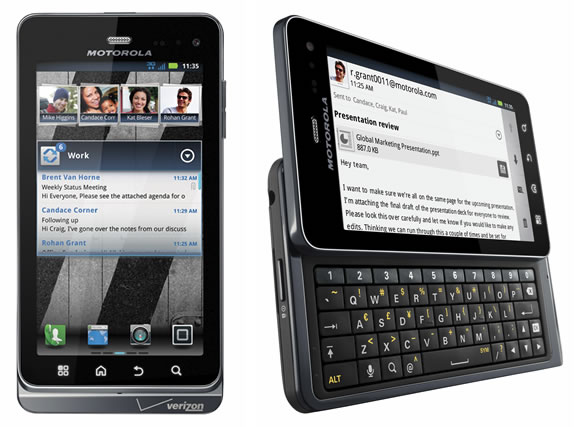Usability, Calling / Data
Usability
While Motorola no longer calls its user interface MOTOBLUR, the MOTOBLUR touch is to be found all over the phone's Android 2.3.4 Gingerbread operating system. Unlike earlier Motorola UI facades, though, this one is almost all good. The widgets can still be resized at will, which I love, but they have lost their cartoonish look and are now backed up by a new main menu that allows for greatly improved organization of apps, thanks to user defined groups.

The DROID 3's dual-core, 1GHz TI OMAP processor speeds the graphics along with little trouble, and the high resolution of the touchscreen display makes everything on the phone look that much sharper. It's a great combination. I'm also pleased with the rather subtle 3D animation effects found when switching from one home screen panel to another, or when swiping left and right through the pages of the main menu.

For some reason the phone is limited to 5 home screen panels, which limits the number of widgets that can be loaded. When you have some really great widgets like Motorola's favorite contacts widget and have the ability to resize them to taste, users are going to want a lot of real estate on the home screen to customize. I'd also like to see some shortcuts to common functions like Wi-Fi and GPS, along with music controls, in the notification area. Most everybody is doing something like that because it's uber-convenient. Motorola should, too.

Users will likely appreciate the look of the new lock screen and the fact that music can be controlled while the device is locked. Motorola's contacts app has been replaced with a more modern version that has an index of letters down the right hand edge and also supports virtual keypad based contact searching from the dial pad. There's absolutely no social networking integration in contacts, though, apart from the ability to draw them down and merge them with existing contacts. If you want to see what your friends are up to, you'll need to do that somewhere else.
While there remains no proper ringer profile support on the DROID 3, it does introduce a very handy Sleep mode that lets you shut down the phone and then reactivate it in mere seconds with an extended press of the power button. This obviates the need for a complete and painful shutdown on an airplane, and lets you get back to your apps faster - right where you left them. It's like a laptop's hibernate function.
Calling / Data
As far as voice service on the Motorola DROID 3 goes, I was pleased with the device's performance on Verizon's network. Inbound audio was very good, and outbound audio seemed average. The speakerphone performed quite well, though it was not completely natural sounding. But it was clear, and I'll take that any day.

Motorola's DROID 3 lacks Verizon 4G LTE support and I'm happy about it. There, I said it. 4G eats battery power and isn't widely available. It makes devices more expensive, bigger, and heavier. But you know what really stokes my fire? GSM/UMTS world roaming, and that's what the DROID 3 has. The DROID 3 will allow you to surf and make calls just about anywhere in the world (for a price). That's something that will appeal to all manner of business users as well as jet-setting vacationers.

As is the case with most every Android smartphone, the D3 supports Wi-Fi networks and USB connectivity. The phone can act as a USB-tethered modem for a personal computer or laptop and also offers Mobile Hotspot support for sharing your 3G data with others over a Wi-Fi connection. Both of those services require an additional monthly fee paid to Verizon, however. Bluetooth wireless support for headsets and stereo headphones is also available.
